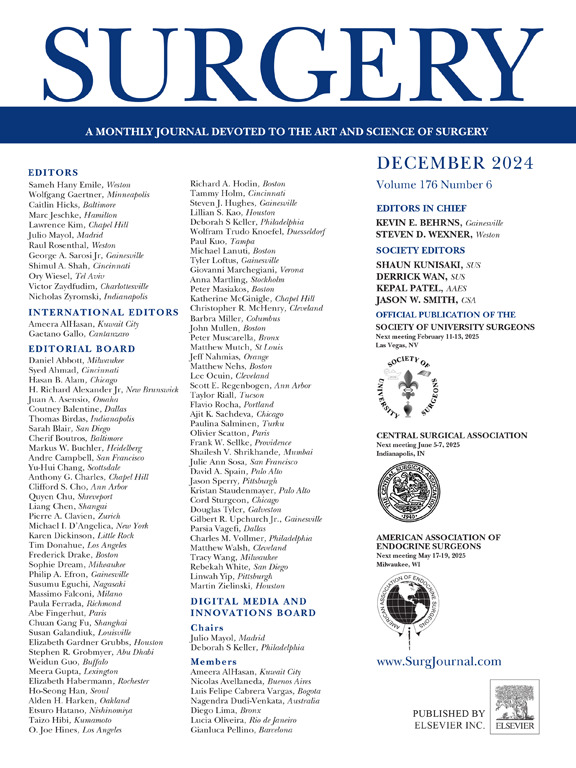Patterns of care and surgical outcomes for early-stage rectal cancer in the United States
IF 3.2
2区 医学
Q1 SURGERY
引用次数: 0
Abstract
Background
Although limited trials have demonstrated the feasibility of rectal-preserving approaches in clinical T1-3N0 adenocarcinoma, local excision after neoadjuvant therapy has been associated with high rates of morbidity. We hypothesized that this strategy would be comparable to the standard, total mesorectal excision. The aim of this study was to describe trends of early-stage rectal cancer management.
Methods
cT1-3N0 rectal cancers in the National Cancer Database (2006–2018) were grouped into 5 treatments: total mesorectal excision, total neoadjuvant therapy + local excision, neoadjuvant chemoradiotherapy + local excision, total neoadjuvant therapy + total mesorectal excision, and neoadjuvant chemoradiotherapy + total mesorectal excision. Morbidity was defined as a combination of readmissions and 30- and 90-day mortality.
Results
We identified 22,793 patients. Neoadjuvant chemoradiotherapy + local excision had the highest proportion of patients ≥70 years (41%) and those with comorbidities (Charlson-Deyo score ≥2, 9%). Median stay was 1 day for local excision and 5 days for total mesorectal excision. Overall composite morbidity was 9%, which, after adjustment, was not statistically different between local excision and total mesorectal excision (odds ratio = 0.45, 95% confidence interval: 0.17–1.19). Among local excision patients, 56% had pathologic complete response, 33% were pStage I, and 12% pStage II-III. In multivariable analysis, all strategies had similar overall survival compared with total mesorectal excision, except for neoadjuvant chemoradiotherapy + local excision, which was associated with worse prognosis (hazard ratio = 1.57, 95% confidence interval: 1.21–2.03).
Conclusion
Although infrequent, neoadjuvant chemoradiotherapy/total neoadjuvant therapy + local excision were associated with high rates of tumor downstaging, suggesting that rectal-preserving strategies are feasible. However, 1 in 8 patients had more advanced disease, which may have compromised future total mesorectal excision planes. Together with the similar morbidity and relatively worse prognosis of neoadjuvant chemoradiotherapy + local excision, these observations should prompt careful patient selection for this approach, while cautioning against its widespread use.

美国早期直肠癌的护理模式和手术结果
背景:虽然有限的试验证明了保留直肠入路治疗临床T1-3N0腺癌的可行性,但新辅助治疗后局部切除与高发病率相关。我们假设该策略可与标准的全肠系膜切除相媲美。本研究的目的是描述早期直肠癌治疗的趋势。方法将国家癌症数据库(2006-2018)中的sct1 - 3n0例直肠癌分为5种治疗方案:全肠系膜切除术、全新辅助治疗+局部切除术、新辅助放化疗+局部切除术、全新辅助治疗+全肠系膜切除术、新辅助放化疗+全肠系膜切除术。发病率定义为再入院和30天和90天死亡率的组合。结果共发现22,793例患者。新辅助放化疗+局部切除的患者≥70岁(41%)和合并合并症(Charlson-Deyo评分≥2,9%)的比例最高。局部切除的中位住院时间为1天,全肠系膜切除的中位住院时间为5天。总体复合发病率为9%,经校正后,局部切除与全肠系膜切除之间无统计学差异(优势比= 0.45,95%可信区间:0.17-1.19)。在局部切除患者中,56%的患者病理完全缓解,33%的患者为pi期,12%的患者为II-III期。在多变量分析中,除了新辅助放化疗+局部切除与更差的预后相关(风险比= 1.57,95%可信区间:1.21-2.03)外,所有策略与全肠系膜切除术的总生存率相似。结论新辅助放化疗/全新辅助治疗+局部切除虽不常见,但肿瘤降期率较高,提示直肠保留策略是可行的。然而,1 / 8的患者有更严重的疾病,这可能危及未来全肠系膜切除术。结合新辅助放化疗+局部切除的相似发病率和相对较差的预后,这些观察结果应提示患者谨慎选择该方法,同时警告其广泛使用。
本文章由计算机程序翻译,如有差异,请以英文原文为准。
求助全文
约1分钟内获得全文
求助全文
来源期刊

Surgery
医学-外科
CiteScore
5.40
自引率
5.30%
发文量
687
审稿时长
64 days
期刊介绍:
For 66 years, Surgery has published practical, authoritative information about procedures, clinical advances, and major trends shaping general surgery. Each issue features original scientific contributions and clinical reports. Peer-reviewed articles cover topics in oncology, trauma, gastrointestinal, vascular, and transplantation surgery. The journal also publishes papers from the meetings of its sponsoring societies, the Society of University Surgeons, the Central Surgical Association, and the American Association of Endocrine Surgeons.
 求助内容:
求助内容: 应助结果提醒方式:
应助结果提醒方式:


